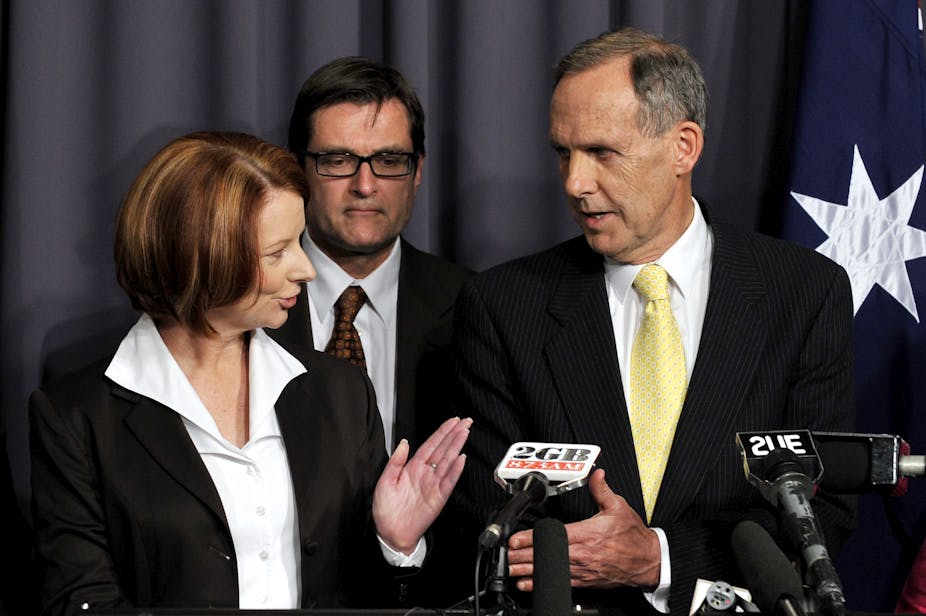Independent MP Tony Windsor was right in early March when he called for a debate on carbon pricing in Australia that is “a little bit more advanced than the word ‘lie’ and the word ‘tax’”.
The quality of the public debate has lifted since, due partly to Ross Garnaut’s latest update paper on carbon pricing and the ensuing discussion.
Until now it has been unclear exactly how a carbon pricing system would be designed, but as elements are gradually introduced, a more sophisticated debate is emerging.
The key question now is: how do we resolve divisions and build public consensus on carbon pricing?
The Multi-Party Climate Change Committee has proposed a fixed and rising price on carbon, which behaves like a carbon tax, followed by a shift to emissions trading. As I argue in a recent paper, this “phased” model offers the best chance of a broad-based and durable consensus on carbon pricing.
Political pressures
Failure to forge a workable societal consensus on climate policy arguably played a major role in Kevin Rudd and John Howard losing their prime ministerships. Climate policy was also the key factor in Malcolm Turnbull being removed as opposition leader.
Policymakers know that the interests of different groups in society need to be balanced in the debate over climate change.
There are citizens who are concerned about the environment and others who are not. Some businesses are heavy emitters of carbon, while others emit very little.
At a party political level, there remains a chasm between the government’s position on Australia’s emissions target and the Greens’. Government policy is a 5% reduction by 2020, relative to 2000, with the possibility of up to 15% or 25%, depending on other countries’ actions. The Greens have called for at least a 25% reduction.
But despite such differences, all sections of the community need to be reasonably content with the policy to make it politically viable.
The phased carbon pricing model helps deal with these political hurdles and probably has the best chance of fostering a broad-based and lasting consensus.
Starting with a government-determined price provides confidence that the short-term impacts on the economy will be manageable. Within this model, there is no risk of cost blow-out to industry, and price impacts on household consumption will not be excessive.
In addition, there will be financial assistance to households and industry. The assistance proposals include income tax cuts and higher social security payments, free permits to emissions-intensive and trade-exposed industries, and support for strongly affected regions.
As a package, this will address many concerns by citizens who are primarily worried about short-term economic effects, and of carbon emitting industries.
Meanwhile, the longer-term parameters of the carbon pricing model can be set so that emissions will start to trend down in over the coming years. Industry can factor carbon price expectations into investment decisions.
As a result, the future carbon price will begin to matter more than the starting price.
The extent to which emissions trend downward is a useful benchmark for the effectiveness of the scheme, given the underlying upward trend in emissions of 1% or more per year. A turnaround in Australia’s emissions trajectory would satisfy expectations by most environmentally concerned citizens.
The fixed-price approach is also attractive because it allows Labor and the Greens to to side-step the thorny question of targets. That is because carbon pricing can get under way before setting a quantitative target.
Economic solutions
Emissions trading has strong advantages as the basis for long-term policy. It lets us meet a given target for emissions automatically at a market price.
It also places the cost risk of meeting the national emissions target on polluters rather than taxpayers, and it allows businesses to use international trading opportunities and financial market instruments.
Linking in with international emissions markets decouples Australia’s target from the carbon price. An additional cut in Australia’s net emissions mostly translates into greater investment in mitigation action overseas, through purchases of international emissions permits. The international permit price then becomes an effective cap for Australia’s price.
However, the conditions are not right yet for internationally linked emissions trading. There is uncertainty about both the level of global climate action and Australia’s reasonable contribution. Trading opportunities in international emissions markets are still emerging, and fears linger of runaway carbon prices wrecking the economy.
Yet the longer we delay on our own carbon pricing model, the higher will be the cost of cutting Australia’s carbon footprint.
Our economic growth, including expansion in resource-intensive industries, drives investment in carbon-intensive infrastructure. Only a price signal or heavy-handed regulation can shift investment to lower-emissions alternatives.
Starting with a fixed price is best in the short term, when emitters need reassurance and international uncertainties – as suggested by the 2008 Garnaut Review.
This is where the Multi-Party Climate Change Committee has got to. From here on in, battles loom over the starting price and its trajectory, and how much of the revenue should go to industry versus to consumers and taxpayers or climate change programmes. How and by how much to support carbon sequestration in forests and agriculture may also shape up as a big issue.
Recently there has been a long overdue discussion on possible income tax cuts, although the government appears reluctant to commit. The debate will not stop there.

